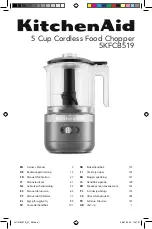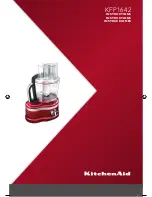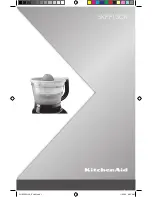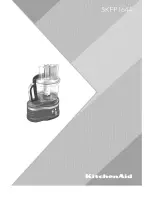
R302 Operation Manual
9
SLICING PLATES
The seven (7) slicing plates range from 1mm (ap-
proximately 3/64") to 6.5mm (approximately 1/4"):
Part Number
MM Slicing
Inches (Approx.)
R291
1mm
1/32 in.
R212
2mm (waved)
5/64 in.
R210
2mm
5/64 in.
R292
3mm
1/8 in.
R211
4mm
5/32 in.
R293
5mm
3/16 in.
R270
6mm
1/4 in.
Plate Usage
SLICING PLATES
R291 1/32" - 1mm Slicing Plate
The thinnest slicing plate is the R291. It is used for
paper thin slicing of potatoes for potato chips. This
plate will also slice carrots lengthwise which can be
soaked in cold water to make flower petals for
garnish.
R210 5/64" - 2mm Slicing Plate
The next to the thinnest of the straight slicing plates
is the R210. It provides a wafer thin slice that
makes harder vegetables look best. Carrots,
radishes, celery and potatoes look terrific through
this plate. This is the best plate for shredded
lettuce for tacos and sandwiches. This is also the
plate for cabbage for a German style slaw.
R292 1/8" - 3mm Slicing Plate
This is one of the new thickness of slice available.
By cutting 1/8" thick it gives good shelf life and
maximum yield. Almost any vegetable can be cut
with this plate and gives greater yield than the
standard slicer which comes with the unit.
R211 5/32" - 4mm Slicing Plate
The R211 is the best all purpose slicing plate. For
most vegetables this thickness is best. Cucum-
bers, mushrooms, zucchini, and celery all cut
beautifully with the R211 while providing a good
shelf life. This is the second most popular plate
requested and comes standard with the unit. Even
soft foods like strawberries, bananas, and green
onion tops slice marvelously.
R293 3/16" - 5mm Slicing Plate
Some foods are more attractive when sliced a bit
thicker and that is the function of the R293. Half
slices of tomato or bell pepper work good as well as
yellow squash and zucchini. Try deep fried thick
slices of potato using the R293 for home fries.
(2) Grating Operation:
Again, prepare the product
as to allow insertion into the feed chute. Consider
which chute will be used. As an example, placement
of carrots horizontally in the large chute will result in
a long grated product, while vertical insertion in the
smaller chute will result in a short grated product. It
is recommended that chilled cheese be used when
grated cheese is desired, otherwise a gumminess may
result. A fine coating of cornstarch applied to the
cheese before grating will aid in keeping the finished
product separated. A fine coating of cornstarch will
not be visible and is tasteless. Grating cheese is one
of the most trying processes and because the nature
of the product may cause overheating of the motor if
not grated in the recommended manner. It is recom-
mended that a slight pulsating pressure be applied
with the pusher while grating, alternating slight pres-
sure on the pusher—no pressure—continuing in this
manner until the block of cheese is completely grated.
It is recommended that the cheese be prepared to fit
(3) Julienne Operation:
Insertion of the product to
be cut must be horizontal if a long stick is to be
achieved, e.g., squash sticks. Vertical insertion will
result in finely chopped products, e.g., chopped cel-
ery. A finely chopped onion product may also be
obtained with this operation.
Plate Utilization
The Robot Coupe food processor will perform a vari-
ety of functions: slicing, grating, French fry, and
julienne. There are a total of 25 different plates avail-
able to perform these functions to meet individual
tastes. The 21 plates consists of:
7 slicing plates
8 grating plates
6 julienne plates
The standard Robot Coupe comes with two (2) plates.
Check your most current price list for the plates which
are included as standard. The number and type of
plates will vary depending upon the use of the ma-
chine.
Summary of Contents for R302
Page 2: ...R302 Operation Manual 2...
Page 16: ......




































